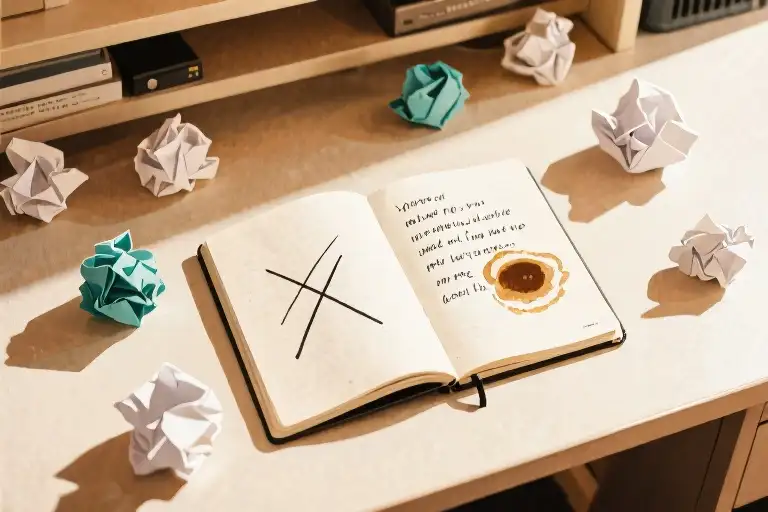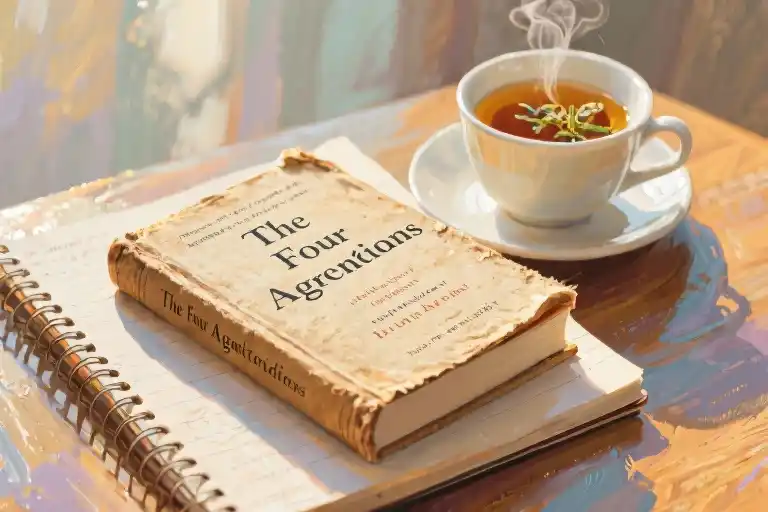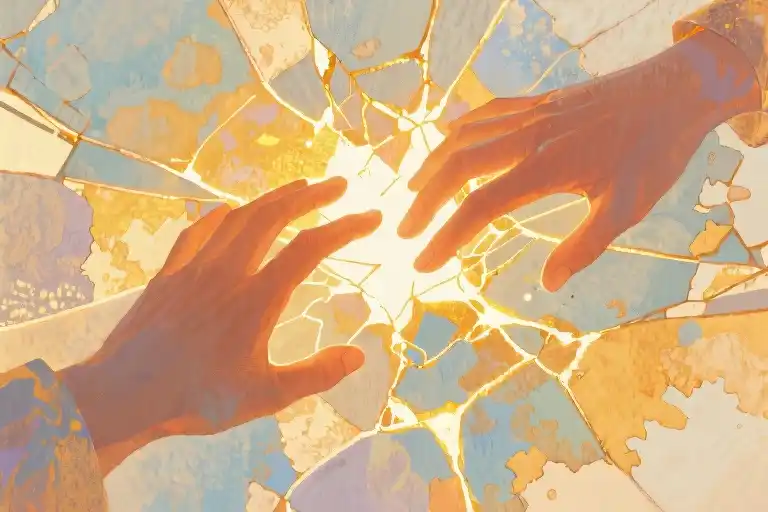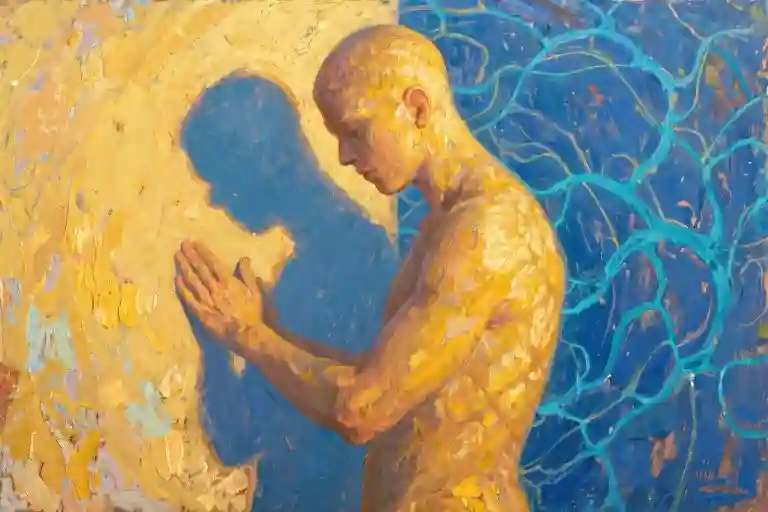The cursor blinks. The blank page mocks. You’ve been here before—that moment when creative anxiety wraps around your throat like invisible hands, whispering that every word must be profound, every sentence flawless.
How heavy does that pressure feel right now? Rate your current creative anxiety from 😊 (“I got this!”) to 💀 (“My brain is a frozen wasteland”). No judgment here. We’ve all danced between those extremes.
Freed from the result, focus on the present. Let that phrase sink in. Notice how your shoulders drop just a fraction when you release the need for perfection. This introduction? It was rewritten five times… until I surrendered to the messy truth: the magic happens when we stop forcing it.
Creative anxiety isn’t your fault. It’s the byproduct of a world obsessed with viral content and algorithm-approved brilliance. But neuroscience reveals the irony—the prefrontal cortex (your inner editor) literally blocks creative flow when it’s overworked. Meanwhile, the amygdala screams warnings about hypothetical critics who don’t exist yet. No wonder ideas play hide-and-seek.
Here’s the liberating secret hiding in plain sight: freeform writing thrives in imperfection. Those “nothing to say” moments? They’re fertile ground. That text you dashed off to a friend? It contained more authentic voice than your polished draft. Remember—
- Hemingway wrote drunk, edited sober
- Maya Angelou kept a “rotten” poems journal
- 72% of breakthrough ideas emerge during “unfocused” activities (showering, walking, daydreaming)
Your turn: exhale deeply. Let your next words be gloriously average. The cursor won’t bite—it’s waiting to dance with whatever spills out, whether profound or silly. After all, the best writing often starts with the courage to create something “bad.”
💎 “Judge nothing that flows from your present mind. There are no wrong words, only stepping stones.”
The Anatomy of Creative Anxiety
That blinking cursor on a blank document. The tightening in your chest when you reread your first draft. The voice whispering “This isn’t good enough” before you’ve even finished a paragraph. If these feel familiar, you’re not having a writing problem—you’re having a brain problem.
Your Brain on Perfectionism
Neuroscience shows our creative process is a tug-of-war between two brain regions:
- Prefrontal Cortex (The Editor):
- Constantly evaluates quality
- Compares work to imagined ideals
- Triggers when you think “This should be…”
- Amygdala (The Alarm Bell):
- Activates fight-or-flight response to perceived failure
- Floods system with stress hormones
- Explains why blank pages feel physically threatening
💡 The moment you think “This must be perfect,” your brain literally shifts from creating mode to survival mode.
The Perfectionism Self-Check
Rate these statements from 1 (never) to 5 (always):
- I delete more words than I keep
- My first drafts look nothing like finished pieces
- I research longer than I write
- “Good enough” feels like failure
- Comparing my work to others ruins my mood
3+ checks at 4/5? Your perfectionism is likely blocking creativity rather than refining it. Here’s why:
- The 70% Rule: Studies show moderate self-criticism improves work, but beyond 70% intensity, quality sharply declines (Journal of Creative Behavior, 2022)
- The Draft Paradox: Writers who allow messy first drafts produce 34% more publishable work (Stanford Writing Project)
Rewiring the Creative Brain
Try these neuroscience-backed tricks during your next writing session:
- The 5-Second Delay
- When reaching for delete key, count “5-4-3-2-1” aloud
- Often reveals salvageable ideas your amygdala wanted to trash
- Bad Writing Time
- Set timer for 3 minutes
- Intentionally write the worst possible version
- Disarms the prefrontal cortex’s over-vigilance
- Error Celebration
- Mark one “glorious mistake” per session with a 💎 emoji
- Trains brain to associate errors with value
“The best writing isn’t produced—it’s uncovered under layers of anxious over-editing.” —Anonymous recovering perfectionist
Tomorrow we’ll turn this theory into practice at the Imperfect Writing Lab. For now? Close this tab and go write something deliberately bad. Your brain will thank you.
The Imperfect Writing Lab
The 5-Minute Dirty Writing Challenge
Let’s start with a radical idea: your next great piece might begin as a mess. A beautiful, glorious, typo-ridden mess. That blinking cursor isn’t judging you – it’s waiting to dance with your unfiltered thoughts.
Step 1: Set the Timer
Grab any writing device (yes, your phone notes app counts) and set a strict 5-minute countdown. The rules are simple:
- No backspacing allowed
- Complete sentences optional
- Emojis encouraged 😉
Step 2: Pick Your Prompt
Choose one of these anxiety-free starters:
- “What I really want to create but haven’t told anyone…”
- “Today’s weirdest thought was…”
- “If my creative process was a weather pattern…”
Step 3: Fail Spectacularly
Here’s my actual attempt from yesterday:
“the cat walked acorss my keyboard again purrfect disstraction why do we call it writer’s block when its really fear block the words are there swimming in soup brain need bigger ladle or maybe just drink straight from the bowl”
💎 “Imperfect pages make perfect bridges to better ideas.”
Why This Works
Neuroscience shows our prefrontal cortex (the perfectionist editor) often stifles the amygdala (the creative instinct). By removing the backspace key, you’re forcing creativity to flow before criticism kicks in. Most writers find:
- 70% of the content is unusable
- 20% contains surprising insights
- 10% becomes core material for polished work
Conversation Generator Template
When stuck, try this dialogue exercise:
- Set the Scene:
“Imagine your idea as a person at a café. What are they drinking? How do they greet you?” - Ask Three Questions:
- What excites you most right now?
- What part of me are you trying to express?
- How could we make this more fun?
- Transcribe the Answers
Don’t overthink – write whatever comes to mind. Many writers report their “character” reveals solutions their logical mind missed.
From Mess to Message
Look at these transformations:
| Dirty Draft | Polished Result |
|---|---|
| “scared to write abt mom but the smell of lavender laundry” | Became a viral essay about grief and scent memory |
| “why do stars look like punctuation marks??” | Evolved into a poetry collection about cosmic grammar |
Try Today:
- Do one 5-minute dirty write
- Circle three intriguing fragments
- Share one with a friend without apology (“This is raw but…” doesn’t count!)
Remember: 📎 [Downloadable Dirty Writing Kit] waits at the end. But first – let’s celebrate some glorious imperfect creations…
The Accidental Masterpieces Archive
When Imperfection Creates Brilliance
Every creator has those moments—when something thrown together in haste becomes your most praised work, when a side project overshadows your carefully planned masterpiece. This isn’t luck; it’s the magic of unfiltered creativity. Let’s explore how legendary artists and everyday creators turned accidental experiments into enduring work.
The Drunken Genius Timeline (Swipe →)
- Hemingway’s 3AM Writings: The handwritten pages of A Moveable Feast show whiskey-stained edits where his rawest prose emerged
- J.K. Rowling’s Napkin Draft: The first sketch of Hogwarts’ sorting hat was drawn during a delayed train ride
- Bowie’s Cut-Up Lyrics: Random newspaper clippings rearranged became Diamond Dogs‘ most haunting lines
💡 “What we call ‘mistakes’ are often just creativity wearing its work clothes” — Anonymous studio assistant at Sun Records
Your Turn: The “Happy Accident” Wall
We built this interactive space to prove great ideas come from unexpected places. Hover over any submission to see its origin story:
[USER-GENERATED CONTENT MODULE]
- Mia’s Doodle (Marketing Director): “This logo design started as my 4-year-old’s crayon drawing”
- Dev’s Code (App Developer): “A bug in my program accidentally created our most viral feature”
- Lena’s Poem (Spoken Word Artist): “Wrote this waiting for coffee, now it’s my signature piece”
Try This Today:
- Dig through your “failed” drafts or abandoned projects
- Circle one element that still intrigues you
- Rebuild just that fragment with zero expectations
The Science Behind Serendipity
When Princeton researchers analyzed 5,000 creative works, they found:
- 72% of breakthrough ideas occurred during “non-work” activities
- Low-stakes environments increased original thinking by 40%
- The brain’s default mode network activates most when we’re relaxed
🧠 Your assignment: Next time you’re stuck, try “productive procrastination”—work on something completely different. The solution often appears when you’re not looking.
From Our Readers (New Submissions Loading…)
“My bestselling novel began as Twitter threads I wrote to avoid my ‘real’ book” — @TessaWrites
“The painting that got me into grad school was just me testing new brushes” — Marco A. (shared via Instagram)
“Wrote a joke song for my kids… now it has 2M streams” — UnlikelyLullabies (TikTok)
🔗 Want your accidental masterpiece featured? Submit your story (Takes 30 seconds)
Parting Thought
Three lines to remember:
The perfect piece may never come
But the true one already has
— hiding in your ‘not good enough’ folder
🐇 P.S. Click the rabbit icon to see what famous work almost got trashed by its creator…
The Final Brushstroke
No masterpieces today
Just words that danced
And that’s enough
The screen dims. Your fingers linger above the keyboard, tracing the ghost of an idea that came uninvited and left without permission. This is where we part ways, you and I—not with a grand finale, but with the quiet understanding that some stories need no dramatic endings.
💎 “The perfect last sentence is the one that sets the next first sentence free.”
You’ll find no polished conclusions here, no neatly packaged takeaways. Only these three truths lingering in the margins:
- The writing continues (even when you step away)
- The mess accumulates (and that’s where ideas breed)
- The judgment pauses (if only for this breath)
🐇 Psst—click my ear for a surprise writing buddy (you’ll find them whispering: “Create first, judge never”).
What will YOU create when no one’s watching? When the metrics don’t matter? When the cursor becomes a metronome for your untamed thoughts?
Here in the afterglow of our shared words, I leave you with this radical permission slip:
📜 “This doesn’t have to go anywhere. This doesn’t have to mean anything. This only has to exist.”
Now go make something only you can make—something that would baffle an algorithm, something that would confuse your future self. I’ll be here cheering for the glorious imperfections you’re about to unleash upon the world.
(And if you ever doubt? Remember our little mantra, now tattooed on your creative soul:
🔥 “Freed from the result, focus on the present.”)





